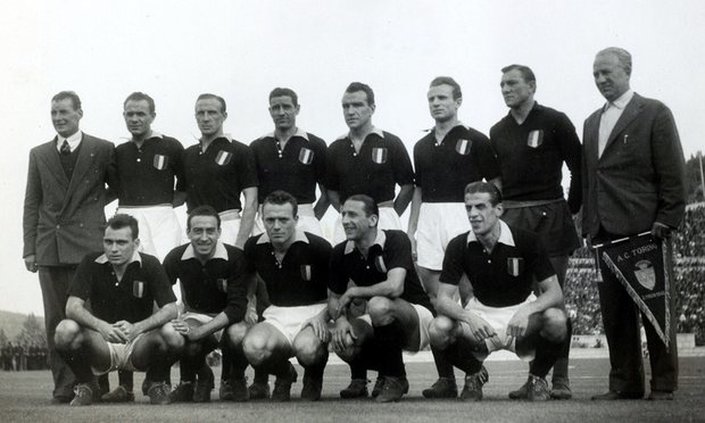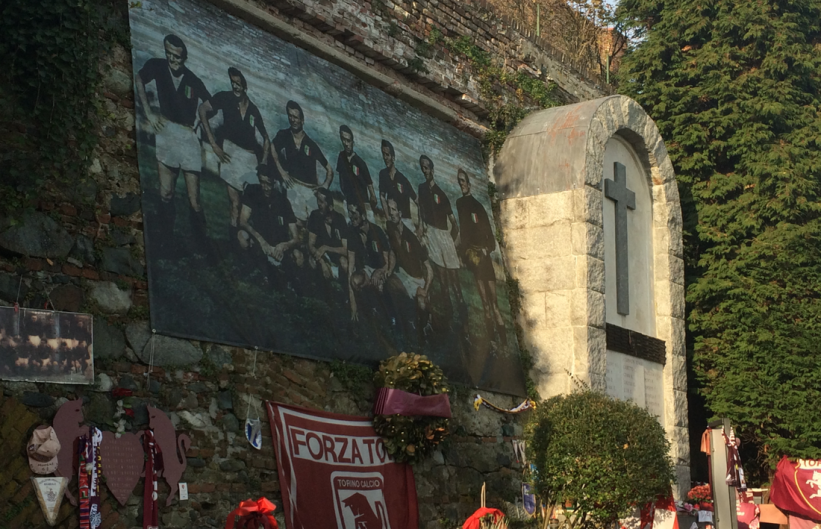At 16:45 on 4 May 1949, Pierluigi Meroni picked up his transmitter and made contact with the Turin air field. “We are over Savona,” his message read when it came through on the ticker. “We fly below the clouds, 2,000 metres, within 20 minutes we will be in Turin.”
At 17:02, as the three-engine plane approached its destination, Meroni received a weather report from the control tower. “Clouds, intense bursts of rain, poor visibility, clouds at 500 metres.”
The experienced pilot, who had tested the Fiat G-212 plane he was flying on a trip from Paris to Milan the previous week, acknowledged the report and replied confidently: “Roger, it’s fine, thank you very much.”
And then, at 17:03, came the final contact with the plane carrying Torino’s famous football team home from Lisbon. “Ok, come in.”
Moments later, an intense flash of light illuminated the misty air above Superga for a second and faded to a glow that lasted long after the impact. On the embankment beside the Royal Basilica of the Savoy, a group of monks led by Don Ricca Tancredi discovered a scene of total devastation, badly burned bodies strewn among the scattered wreckage of the plane. After opening a suitcase filled with granata shirts, it became clear to them who these men were: the decorated Grande Torino squad whose faces had been instantly recognisable in every corner of Italy. They had won every Italian league championship since the end of the war. Now, most of them could only be identified by their possessions.
“Rescuers brought 20 partly charred bodies out of the tangled wreckage,” the first Associated Press release announced, “but it was believed that the death toll would be between twenty-nine and thirty-one.” The higher estimate was accurate.
Soon, the news began to spread through the city below where the shocked Torinese public tried to separate fact from fiction as gossiping voices carried the hideous events from street to street. “It was a bit bizarre,” admitted Bill Lievesley, whose father Leslie was Torino’s assistant coach and the only Englishman in the crash. “There wasn’t a television or anything like that and it started to come through as rumours: ‘There’s been a terrible disaster! There’s been a plane crash!’ Gradually, it filtered through that it was the Torino team and I just remember feeling completely confused by it all – that much I can remember. I was only a kid of ten and you don’t know what’s happening, where you’ve got to go, or what.”
He was not alone in feeling numb. Many in Torino found it difficult to imagine their heroes were dead. Several hours after the crash, Stampa Sera writer Guilio De Benedetti, whose colleague Luigi Cavallero was among the victims, made his way to the morgue at the general cemetery. He described the cold reality of the scene before him:
“A low chamber – bare – its whitewashed walls cracked here and there; on the ceiling a large condensation stain spreads into the strange shape of an octopus. Hanging from the centre, by a thread, there is a lampshade made of tin, but it is empty, broken, missing a light bulb; on the walls are small windows in wooden frames, but there is no glass; the floor is tiled, cold; in the corner a crack stretches towards the centre of the room.”
“They were placed side by side, almost on top of each other, in this mortuary, with a name as cold as its walls: morgue – the name of death, who welcomed the youth of Turin.”
Standing among the 31 bodies were the deputy public prosecutor, a chancellor, two doctors and the men who had come to identify the dead: former national team boss Vittorio Pozzo, club secretary Igino Giusti and a well-known supporter called Signor Rabezzana. Many of the bodies were unrecognisable but for the rings on their fingers and the documents in their back pockets.
It was not just the gruesome condition of the bodies that was laid bare in the days following the crash. So, too, was the emotion of the city, the symbolic power of the Grande Torino and the connection they enjoyed with the Italian people. One local woman hanged herself in her bedroom, leaving a note on which she had scrawled that she could not go on living after the tragedy at Superga. She was discovered by her son.
It is impossible to overstate how important the granata ragazzi had become in the collective imagination of the city that had been targeted by bombs from both sides of the conflict during the war and had never shown any more than vague support for the Fascist regime that had dragged them towards that fate. Their football team had been one of the first symbols of hope after those dark days and now those heroes had been taken from them, at the peak of their powers, in the most shocking circumstances.
Grande Torino.
Even in death, the Grande Torino required police jeeps to force back the crowds desperate to get close to them, just as they had done outside their hotels during away trips. More than 500,000 people took to the streets for the funeral two days after the crash and the Palazzo Madama, where the bodies had been laid in a chapel of rest, was besieged by mourners who wanted to catch one last glimpse of their idols. That evening, the Stampa Sera carried a photograph of the distraught crowd surging forward outside the senate building and a line of soldiers lunging desperately into them to prevent them from breaking through towards the funeral procession. There was no room for the sea of mourners to move in the city centre as columns of people made their way down the main thoroughfares via Po, via Roma and via Garibaldi while desperate locals climbed statues to escape the crush and get a better view of proceedings.
The vast Piazza Castello was swarming with people, many of whom had never been to the Stadio Filadelfia but had been lifted by the swell of pride these men had brought to their city. The players and management of Juventus were among those who bowed their heads in front of the coffins in the Palazzo Madama. The bianconeri squad had already departed for Sicily ahead of their away game at Palermo when they received news of the crash, but they turned around and returned to Turin to honour their fallen rivals. It was a sign of the respect between the two teams who had enjoyed so many hard-fought derby matches down the years. In fact, upon hearing news of the crash two days earlier, Juve’s legendary no-nonsense midfielder Teobaldo Depetrini had been among the first people to make his way up to the top of the Superga hillside. That summer, in a remarkable gesture, he signed for Torino as their desperate president, Ferruccio Novo, attempted to rebuild his squad from scratch.
Telegrams of condolence poured in from countries far and wide, including England, where Stanley Matthews – who had played against several of the Grande Torino side in England’s defeat of Italy a year earlier – spoke about the accident in the Sporting News. “What has happened seems impossible,” he said. “I was tied to the players of Torino by a bond of sporting friendship that I will never forget. I understand very well the pain of Italian football and, in particular, that of Torino.”
Several South American football associations declared May 4 a ‘Day of Football’ in solidarity with the fallen Torino team who had made such an impression when they crossed the Atlantic Ocean the previous summer for a series of friendly games. River Plate went further than any club, flying to Italy to play a fundraising friendly match in the aftermath of the crash. It signalled the start of a unique friendship between the two clubs, who even used each other’s home colours for their away kits in the decade that followed.
For the remaining four games of the 1948/49 campaign, Torino fielded their youth team, and their opponents respectfully followed suit. They finished the season five points clear of Inter, having lost only three games – all of them away from home. The Grande Torino had not lost a home game for more than six years.
Every year, supporters and players of Torino come to the Basilica di Superga to remember Grande Torino
“Before we all offer our final goodbye, I fulfil a solemn duty. I announce to you, dear brothers, that Torino have won a fifth championship. You have won it one more time. I will still see the young boys who have watched you through the fences at the ground and have learned from you the sublime art of the ball – because you were the masters – and I will see in them that they have learned from you the loyalty, the will, the profound love for the sport. And it will all be for you.”
Barassi went on to read out the names of the dead, before turning to Mazzola’s coffin to conclude his eulogy. “Captain Valentino,” he said. “This is the cup, the fifth cup; smile. It is a great cup. Torino’s cup. Look at it. It is so great that I cannot see where it ends. As big as the world. It contains the hearts of all the world. Feel these hearts as they throb. Feel them. Listen to them, Valentino. God bless you.”
That evening, each coffin was placed on the back of a flatbed truck, surrounded by flowers, and the funeral procession, led by the youth teams of Torino and Juventus, dressed in full match kit, made its way to an official memorial ceremony at the Duomo. This was the first chance for many in the crowd to see the pale maplewood caskets of their heroes.
They mourned the 31: the pilots Pierluigi Meroni and Cesare Biancardi; the flight crew members Antonio Pangrazi and Celeste D’Inca; the tour organiser Andrea Bonaiuti; the journalists Renato Casalbore, Renato Tosatti and Luigi Cavallero; the club directors Rinaldo Agnisetta and Ippolito Civalleri; the masseur Ottavio Cortina; the first-team coach Leslie Lievesley; the Grande Torino squad: Valerio Bacigalupo, Aldo Ballarin, Dino Ballarin, Emile Bongiorni, Eusebio Castigliano, Rubens Fadini, Guglielmo Gabetto, Ruggero Grava, Giuseppe Grezar, Ezio Loik, Virgilio Maroso, Danilo Martelli, Valentino Mazzola, Romeo Menti, Piero Operto, Franco Ossola, Mario Rigamonti and Giulio Schubert; and their manager Ernő Egri Erbstein.
Words by Dominic Bliss: @theinsidelefty
An abridged extract from ‘Erbstein: the triumph and tragedy of football’s forgotten pioneer’, by Dominic Bliss. The book is available to buy from Blizzard books here: https://www.theblizzard.co.uk/shop/product/erbstein-footballs-forgotten-pioneer



